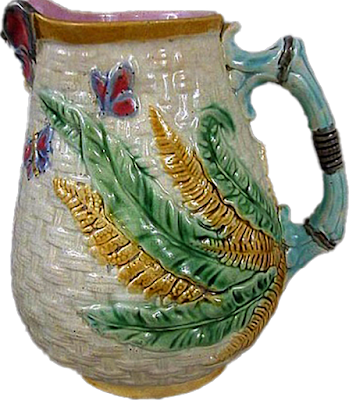 |
| Picturing the citrus representative of the area is this turn of century poster for Menton |
It is probably something of a redundancy to refer to a special type of French majolica as "Barbotine" since it is a generic term that is in general use in France to encompass all forms of majolica and Faience. In reality however it describes any slip form ceramic body that has applied decoration added to it. Specifically what I am referring to is majolica with flowers, fruits and animals applied separately from the body and covered with majolica glazes. While you see a bit of English majolica potted in this manner, the French were particularly adept at this kind of trump-l'oil decoration and used it extensively. They even have their own term for it, "garnissage." It is a form of decoration that has been popular in hard paste European porcelain for hundreds of years. In the late Victorian period it was extended by the French and English to include soft paste work in earthenware with majolica glazes.
The final result is wildly ornate and completely over the top by today's standards of taste but for the Victorian it fit in well within their design philosophy that there is no such thing as too much ornamentation. As you may suspect, this type of decoration is highly subject to damage, particularly done in the soft bodied earthenware that majolica was made of. It is virtually impossible to find an example today without some degree of damage. The one positive note here is that most pieces have so much detail that a broken petal or leaf is easily lost in the overall decoration. Unlike other forms of French majolica, Barbotine work has a limited market in the United States among majolica collectors. It is much more popular on the European continent. There is one manufacturer of this type of work though, whose work is very much in demand among American majolica collectors. The manufacturer to which I refer is the Perret-Gentil factory in Menton, France, commonly referred to simply as Menton.
The pottery industry on the French Riviera has been active manufacturing utilitarian ware since the Greek era. The area is known for its blue seas and abundant citrus. It is the only area in all of Southern France to which the lemon tree is native. As such the symbolic fruit of Menton, the lemon, is frequently used as a decorative motif. In the late 1800's the area's azure shores and beautiful weather became popular with Victorian tourists looking for relief from the Northern European climate. With the creation of majolica the popularity of colorful pottery modeled as citrus and other fruit developed as a souvenir market catering specifically to these tourists.
Perret-Gentil's pottery is not the only Barbotine manufacturer in Menton but it is certainly the best known. The pottery in Menton was established in 1879 by Leopold and Marie Magnat. Leopold died in 1893 but it was not until 1897 that Swiss potter Eugène Perret-Gentil bought the pottery from Marie when he began production of his own line of pottery. The pottery is still in operation today. The peak of its manufacture of Barbotine majolica started around 1890 and continued until around 1920. The work the pottery has produced since is decorative utilitarian ware most frequently decorated with citrus.
The pottery industry on the French Riviera has been active manufacturing utilitarian ware since the Greek era. The area is known for its blue seas and abundant citrus. It is the only area in all of Southern France to which the lemon tree is native. As such the symbolic fruit of Menton, the lemon, is frequently used as a decorative motif. In the late 1800's the area's azure shores and beautiful weather became popular with Victorian tourists looking for relief from the Northern European climate. With the creation of majolica the popularity of colorful pottery modeled as citrus and other fruit developed as a souvenir market catering specifically to these tourists.
A Victorian view of the Riviera at Menton
Menton mark on the above pitcher
The pottery of Eugène Perret-Gentil is seen today as one of the most important of the Côte d'Azure as it is credited for having developed this market for decorative pottery that has transformed the fortunes of many in the area to this day. Today, signed Perret-Gentil majolica brings top dollar on the antique market. It's easy to see why. Whose spirits wouldn't be raised by its bright, sun drenched colors and realistic life sized citrus. It's like bringing a part of the French Riviera home with you.




















































